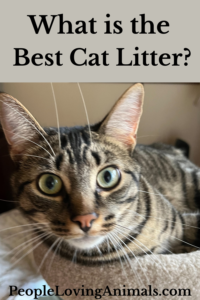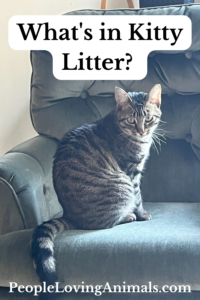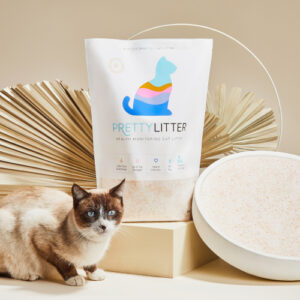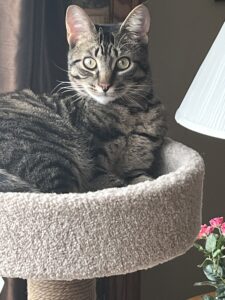There are several different types of cat litter available, but most of them fall into three categories: clay-based litter, silica-based litter and biodegradable litter. What’s in kitty litter depends on which category the litter falls into.
In this post, we’ll cover:
- What is in Cat Litter?
- Pros and Cons of 3 Types of Cat Litter
- Can Cat Litter Be Dangerous to Cats and Humans?
- What is the Best Cat Litter?
- Help with Litter Box Training
![]()
watch my video: what is in Cat litter?
 What is in Cat Litter?
What is in Cat Litter?
The granulated clay used in traditional clay-based litters can absorb its weight in cat urine. But the downside is that once the clay is wet, it can’t absorb any more urine, and it doesn’t clump, so the litter has to be changed often.
Some contain bentonite clay, which can be scooped, but it’s a bit more expensive. You can see a selection of clay-based kitty litter on Amazon, here.
Silica-based cat litter contains silica gel, which is absorbent and helps control odor, so much so that it can be used for up to a month at a time. This type of kitty litter also tends to be less dusty than clay cat litters. You can see a variety of silica-based kitty litters on Amazon, here.
Kitty litters that are biodegradable can be an eco-friendly alternative to clay and silica-based cat litters. These are commonly made from recycled paper products and materials derived from plants. You can see a selection of biodegradable cat litter on Amazon, here.
 Can Cat Litter Be Dangerous for Cats and Humans?
Can Cat Litter Be Dangerous for Cats and Humans?
Some cat owners prefer not to use certain types of cat litter because of the possibility that they can be dangerous if the cat ingests the litter. I personally haven’t witnessed any of my adult cats eating cat litter, but kittens certainly will.
Cats licking their feet after being in the litter box results in a certain amount of ingestion of cat litter.
Some cat owners are also concerned with the dust from cat litter and whether it’s dangerous for cats or humans to inhale.
From what I’ve learned thus far, it’s my understanding that a large amount of cat litter would have to be consumed for it to be dangerous (the same is true of clay-based litter as well as silica-based litter). I also researched whether breathing dust from cat litter is dangerous for cats.
I came up with completely opposite reports and opinions, even by various veterinarians. So unfortunately, I cannot make an educated statement either way, regarding ingesting cat litter or inhaling the dust from it.
I personally like to err on the side of caution, so I tried a cat litter for my new kitten, Whiskers, that was all-natural. He refused to use it. I mean outright refused, choosing to pee in one of my potted house plants instead! (I saw it…ugh!)
 What is the Best Cat Litter?
What is the Best Cat Litter?
I still don’t know for sure! I’ve researched the topic to the best of my ability and continue to find differing opinions by cat litter manufacturers and veterinarians.
I have to say, though, that PrettyLitter may be what I end up going with. That’s only if Whiskers will use it. I’ve seen their commercials on TV and I’m intrigued by the promises they make.
They address the safety issues quite convincingly on their website with the following statements:
“It Doesn’t Contain Harmful Sealants: Traditional litter often contains sodium bentonite, a sealant that expands when it comes into contact with moisture. It’s easy to get onto your cat’s paws, and once she steps out of the litter box to lick them, that clay can expand within her digestive tract.”
“It Won’t Cause Breathing Problems: PrettyLitter uses naturally occurring ingredients that are safe for cats, even when they breathe or ingest it. What’s more, if you or your cat have asthma or a similar condition, you’ll appreciate the fact that crystal litter produces virtually zero dust.”
“It’s Formulated for Felines: Despite what you may have heard, the silica gels found in many crystal litters are not poisonous. They’re actually made from sodium silicate, a naturally occurring mineral that soaks up moisture like a sponge.”
The price of PrettyLitter is $22 per month (it looks like they offer 15% off your first order). I’m currently paying about $9 per month for Tidy Cat. That’s a difference of $13 per month for cat litter. I’m thinking it’s worth it for the dust issue alone.
The dust covers everything in my house and I’m convinced, no matter what the experts say, that it can’t possibly be good for me and Whiskers to be inhaling it. What are your thoughts? Please comment below!
 For Help with Litter Box Issues
For Help with Litter Box Issues
If you’re having any difficulties with your cat not using the litter box, read my article, How to Stop a Cat from Urinating in the House (includes a video). It goes over 10 common reasons why cats won’t use the litter box. (That’s my cat Whiskers in the pic).
 I Donate to Animal Charities
I Donate to Animal Charities
Thank you for visiting my website! If you make a purchase of any of the cat litters linked in this post (PrettyLitter or the ones on Amazon), I will receive a small commission.
I donate 10% of my earnings to animal charities. You can see a list of the charities I donate to here. If you like this website, please share it with your friends! Thanks so much. Debra





 For Help with Litter Box Issues
For Help with Litter Box Issues I Donate to Animal Charities
I Donate to Animal Charities

I’ve liked Pretty Litter the best so far. In the past, I’ve used Swheat scoop. It was pretty good, but if you have any trouble with mice, they seem to like it too. Pretty litter does have to be changed every month or it does start to smell like urine. And, it’s more expensive, but it’s what I’ve chosen for now. Warning, your kitten might need a mixture at first. I used Kitten Attract litter first, then blended it with Pretty before switching over.
OMG I never thought about mice! Thanks for sharing that. Blending it at first is very smart. I switched a cat’s litter too quickly once and he peed in one of my house plants/trees!
Most recently I’ve been trying the advice given in this hugely popular video on YouTube:
https://youtu.be/LhgynG941D8?si=6gHe6GmnN39fk6se
So far, I’m liking it. It’s super inexpensive and easy to use, and my cat had no trouble using it. It doesn’t have the benefit of Pretty Litter in that it won’t change color, etc., to let you know if your cat has a health issue. And the bottom pan needs to be changed twice per week or there’s a smell. But it’s easy to do. And especially for people who have low income, this is an inexpensive way! Debra